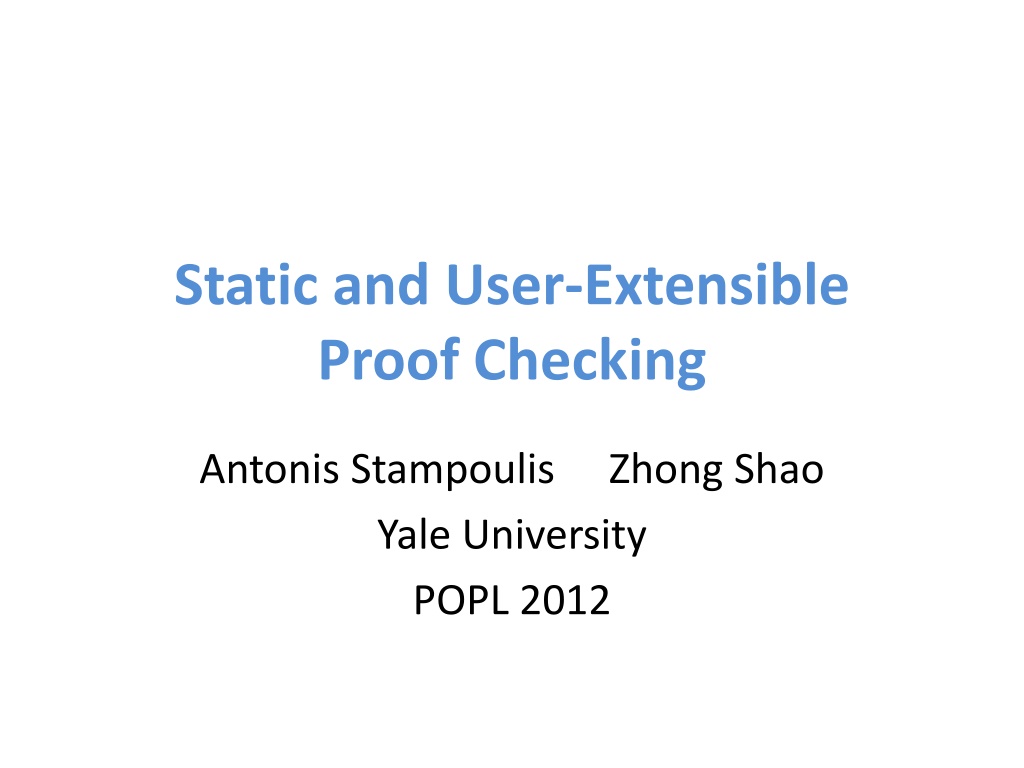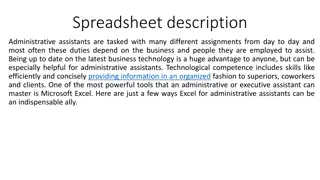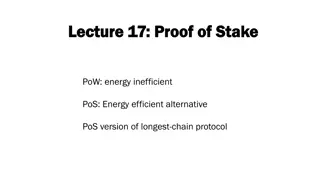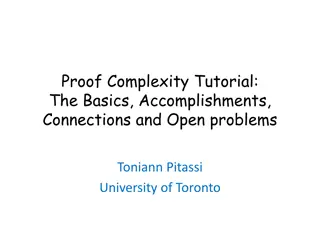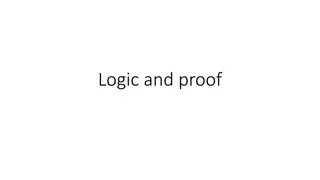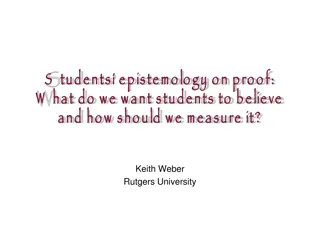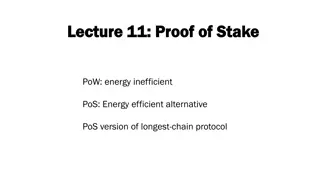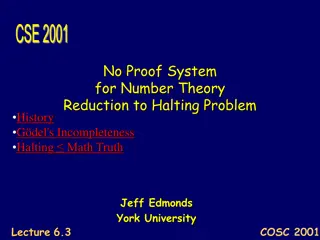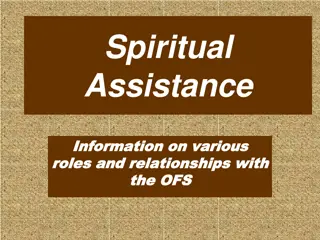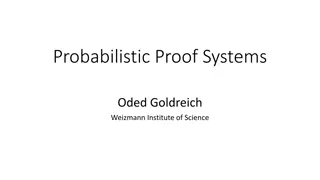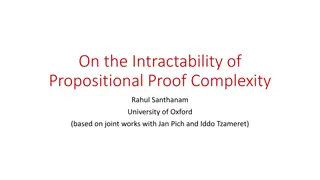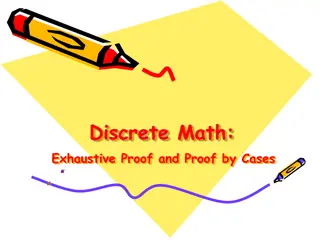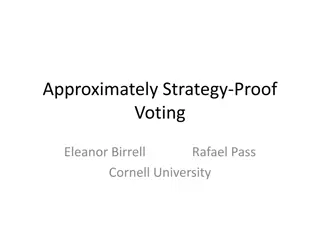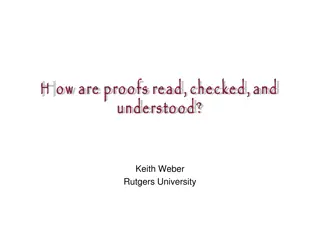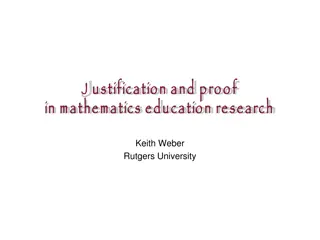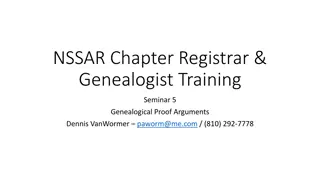Exploring Architecture and Challenges of Proof Assistants
Explore the architecture of proof assistants, discussing the use of tactics, formal proofs, and the difficulty in utilizing these tools. Discover the contribution of a new architecture for proof assistants, addressing extensibility and error checking, with a focus on soundness guarantees. Delve into the main notions of proof objects, derivation in logic, and the checking of proof objects using various tactics and programs to produce proofs. Overall, understand the complexities and advancements in the field of proof assistants.
Download Presentation

Please find below an Image/Link to download the presentation.
The content on the website is provided AS IS for your information and personal use only. It may not be sold, licensed, or shared on other websites without obtaining consent from the author. Download presentation by click this link. If you encounter any issues during the download, it is possible that the publisher has removed the file from their server.
E N D
Presentation Transcript
Static and User-Extensible Proof Checking Antonis Stampoulis Yale University POPL 2012 Zhong Shao
Proof assistants are becoming popular in our community CompCert [Leroy et al.] seL4 [Klein et al.] Four-color theorem [Gonthier et al.] but they re still hard to use 1 to 1.5 weeks per paper proof page 4 pages of formal proof per 1 page of paper proof [Asperti and Coen 10]
Formal proofs communicated to a fixed proof checker must spell out all details use domain-specific lemmas Informal proofs communicated to a person rely on domain- specific intuition use obviously calculus linear algebra arithmetic
We need tactics to omit details - untyped procedures that produce proofs domain-specific tactics good in large developments but difficult to write! - proofs within tactics can be wrong!
Proof assistants are hard to use because 1. cannot extend proof checker lots of details 2. no checking for tactics lots of potential errors These are architectural issues
arithmetic Our contribution: intuition stack congruence full programming model soundness guaranteed - A new architecture for proof assistants conversion 1. extensible proof checker omit lots of details 1. cannot extend proof checker lots of details 2. no checking for tactics lots of potential errors 2. extensible checking for tactics lots of errors avoided More specifically: - a new language design - a new implementation - and a new metatheory static checking of contained proofs based on VeriML [ICFP 10]
Architecture of proof assistants: main notions Proof object Derivation in a logic Proof checker Checks proof objects Tactic Function producing proof objects Combination of tactics; program producing a proof object Proof script
Architecture of proof assistants: Checking proof objects Conversion rule Proof object Implicitly check equivalences (proof omitted) Proof checker Conversion
Architecture of proof assistants: Checking proof objects Proof object Coq -conversion Proof checker Conversion
Architecture of proof assistants: Checking proof objects Proof object CoqMT -conversion + linear arithmetic Proof checker Conversion
Architecture of proof assistants: Checking proof objects - rich static information - (de)composable - checking not extensible Proof object Proof checker Conversion
Architecture of proof assistants: Validating proof scripts Arithmetic tactic Proof script User tactic - extensible through tactics - rich programming model - no static information - not (de)composable - hidden proof state Other tactic evaluation Proof object Proof checker use conversion for more robust scripts Conversion
Moving to typed proof scripts Arithmetic tactic Arithmetic tactic Typed proof script Proof script User tactic User tactic Other tactic Other tactic Type checker evaluation evaluation Proof object Proof checker checker Proof Conversion Conversion
Moving to typed proof scripts + extensible conversion Arithmetic tactic Typed proof script User tactic Key insight: conversion is just a hardcoded trusted tactic Other tactic Type checker Proof checker but we can trust other tactics too if they have the right type Conversion User-defined Conversion evaluation
Moving to typed proof scripts + extensible conversion Typed proof script Key insight: conversion is just a hardcoded trusted tactic Other tactic Type checker Type checker Proof checker Proof checker but we can trust other tactics too if they have the right type Conversion User-defined Conversion User-specified Conversion none of them needs to be hardcoded! evaluation
Typed proof scripts + extensible conversion Typed proof script - rich static information - user chooses conversion - extensible static checking - smaller proof checker - can generate proof objects Type checker Proof checker User-specified Conversion evaluation
Metatheory result 1. Type safety Type checking tactics: an example If evaluation succeeds, the returned proof object is valid Metatheory result 2. Proof erasure If evaluation succeeds, a valid proof object exists even if it s not generated - check propositions for equivalence - return a proof if they are - raise an exception otherwise
Two modes of evaluation Typed proof script Type checker proof object Proof checker evaluation User-specified Conversion mode controlled per function proof erasure evaluation
Static checking = type checking + staging under proof-erasure Typed proof script typechecking Type checker Proof checker stage-one evaluation with proof erasure User-specified Conversion evaluation of residual program evaluation
A stack of conversion rules arithmetic simplification congruence closure ring_simplify for Nat close to CoqMT no additions to logic metatheory actually, with reductions -conversion makes most uses of rewrite/autorewrite unnecessary conversion in Coq no proof by reflection or translation validation leveraging static proof scripts removed from trusted base
A stack of conversion rules arithmetic simplification na ve arithmetic conversion congruence closure potentially non- terminating reduce proving for real versions na ve equality conversion - conversion
Motivating Coq Example Require Import Arith. Variable x : Nat. Theorem test1 : 0 + x = x. trivial. Qed. Theorem test2 : x + 0 = x. trivial. Qed.
Motivating Coq Example Require Import Arith. Variable x : Nat. Theorem test1 : 0 + x = x. trivial. Qed. Proof completed Theorem test2 : x + 0 = x. trivial. Qed.
Motivating Coq Example Require Import Arith. Variable x : Nat. Theorem test1 : 0 + x = x. trivial. Qed. Attempt to save an incomplete proof Theorem test2 : x + 0 = x. trivial. Qed.
Motivating Coq Example Require Import Arith. Variable x : Nat. Conversion rule can prove this Theorem test1 : 0 + x = x. trivial. Qed. but can t prove this Theorem test2 : x + 0 = x. trivial. Qed.
Lets add this to our conversion rule! - - - write a rewriter based on these lemmas register it with conversion now it s trivial; lemmas used implicitly
similar to trivial uses conversion P and P inferred not checked statically recomputed many times
checked at definition time computed once transformation of runtime arguments to constant arguments
Implementation http://www.cs.yale.edu/homes/stampoulis/ type inferencing and implicit arguments compiler to OCaml rewriter code generation inductive types Talk to me for a demo!
Whats in the paper and TR Static and dynamic semantics Metatheory: Type-safety theorem Proof erasure theorem Static proof script transformation Implementation details and examples implemented Typed proof scripts as flexible proof certificates
Related work proof-by-reflection restricted programming model (total functions) tedious to set up here: no need for termination proofs automation through canonical structures / unification hints restricted programming model (logic programming) very hard to debug
Summary a new architecture for proof assistants user-extensible checking of proofs and tactics minimal trusted core reduce required effort for formal proofs Thanks! http://www.cs.yale.edu/homes/stampoulis/
Type checking proofs and tactics -manipulate proofs and propositions in a type-safe manner -dependent pattern matching on logical terms -logic and computation are kept separate -Beluga [Pientka & Dunfield 08] -Delphin [Poswolsky & Sch rmann 08] -VeriML [Stampoulis & Shao 10] Type checker Proof checker
Related work LCF family of proof assistants no information while writing proof scripts/tactics Coq / CoqMT conversion rule is fixed changing it requires re-engineering NuPRL extensional type theory and sophisticated conversion here: user decides conversion (level of undecidability) Beluga / Delphin use as metalogic for LF here: the logic is fixed; the language is the proof assistant
